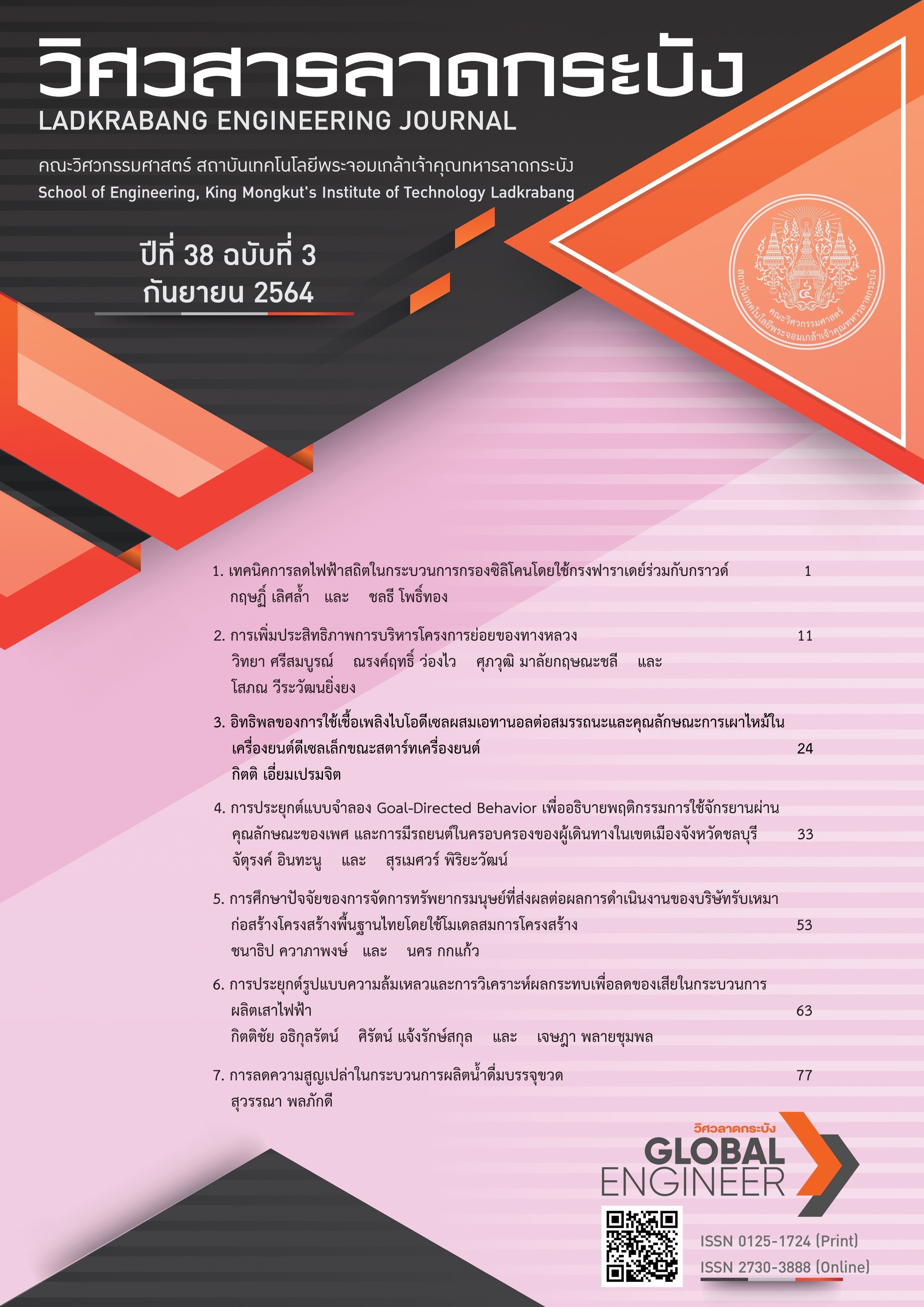Waste Reduction in Bottled Water Production Process
Keywords:
bottled water production processes, wastes, Value Stream Mapping (VSM), lean conceptsAbstract
The purpose of this research is to find and eliminate eight wastes of the Lean way by applying Value Stream Mapping (VSM) method to bottled water process. The key performance indicator for this research is the Lead Time (LT) for this industry, which has four main processes: water treatment, filling water to bottle, packaging to pallet and shipping to customer. The results of the current value stream mapping after analyzed the wastes found that two main wastes came from excessive processing and inventory. To reduce the effect of these wastes, the process improvement like a new design-scale for counting pallet sheets, the change of an accurate design-function for to filling in the MS-Excel file, was taken into account for eliminating the excessive process waste; moreover, and applied of Economic Production Quantity (EPQ) to eliminate the oversize of the inventory waste. The good results were found that the lead time of the bottled water industry will be decreased from 230,598 seconds to 228,588 seconds (reduced 33.5 minutes) or 0.88 percent
References
NALISA, “bottled water market” marketeeronline.co. https://marketeeronline.co/archives/217681 (accessed Jun. 28, 2021)
M. Helmold, “Basics in Lean Management,” in Lean Management and Kaizen: Fundamentals from Cases and Examples in Operations and Supply Chain Management, Cham, Switzerland: Springer, 2020, pp. 1–14.
N. Balakrishnan, “Toyota Production System,” in Dependability in Medicine and Neurology: Using Engineering and Management Principles for Better Patient Care, Cham, Switzerland: Springer International Publishing, 2015, pp. 239–260.
R. S. Barot, K. Raval, H. Beravala and A. Patel, “Implementation of lean practices in water heater manufacturing industry,” Materials Today: Proceedings, vol. 38, pp. 2227–2234, 2021, doi: 10.1016/j.matpr.
06.304.
A. K. Dhingra, S. Kumar, and B. Singh, “Cost reduction and quality improvement through Lean-Kaizen concept using value stream map in Indian manufacturing firms,” International Journal of System Assurance Engineering and Management, vol. 10, no. 4, pp. 792–800, 2019, doi: 10.1007/s13198-019-00810-z.
P. Ribeiro, J. C. Sa, L. P. Ferreira, F. J. G. Silva, M. T. Pereira and G. Santos, “The Impact of the Application of Lean Tools for Improvement of Process in a Plastic Company: a case study,” Procedia Manufacturing, vol. 38, pp. 765–775, 2019, doi: 10.1016/j.promfg.2020.01.
Kanitsorn Poonikom, “Efficiency Improvement in Manufacturing Process by Improvement Technique Case Study: Drinking Water Bai-Pai-Keaw”, in Industrial Engineering Networking Conference 2017, Chiang Mai, Thailand, 2017, pp.150–155.
W. Jantana and W. Sapsanguanboon, “Productivity Improvement in Ceramic Production Process: A Case Study of Factory in Samut Prakan Province,” Songklanakarin Journal of Management Sciences, vol. 37, no. 2, pp. 58–83, 2020.
W. Cheewaworanontree, P. Rontlaong, and N. Boonrak, “Motion and Time Study: A Case Study on A Short-Time Hydrostatic Failure Pressure Testing Process of Rigid PVC Plain-End Pipes,” The Journal of Industrial Technology: Suan Sunandha Rajabhat University, vol. 6, no. 1, pp. 26–38, 2018.
P.Krailomsom, T. Miengarrom, W. Leelawan “Increasing the Efficiency of the Bottled Water Packaging Process Movement by Using the Kaizen Concept: Case Study Drinking Water Factory,” Industrial Technology Research Journal Phranakhon Rajabhat University, vol.3, no. 2, pp.1–8, 2020.
W. Impho and K. Poonikom, “Increasing efficiency in the production process of drinking water using lean technical: Case study of drinking water Thanthip production,” SNRU Journal of Science and Technology, vol. 9, no. 3, pp. 653–660, 2017
P. Roh, A. Kunz and K. Wegener, “Information stream mapping: Mapping, analysing and improving the efficiency of information streams in manufacturing value streams,” CIRP Journal of Manufacturing Science and Technology, vol. 25, pp. 1–13, 2019, doi: 10.1016/j.cirpj.2019.04.004.
N. Thinakaran, J. Jayaprakas and C. Elanchezhian, “Survey on Inventory Model of EOQ & EPQ with Partial Backorder Problems,” Materials Today: Proceedings, vol. 16, pp. 629–635, 2019, doi: 10.1016/ j.matpr.2019.05.138.
A. A. Taleizadeh, V. R. Soleymanfar and K. Govindan, “Sustainable economic production quantity models for inventory systems with shortage,” Journal of Cleaner Production, vol. 174, pp. 1011–1020, 2018, doi: 10.1016/j.jclepro.2017.10.222.
S. Kumar, A. K. Dhingra and B. Singh, “Process improvement through Lean-Kaizen using value stream map: a case study in India,” The International Journal of Advanced Manufacturing Technology, vol. 96, no. 5–8, pp. 2687–2698, 2018, doi: 10.1007/s00170-018-1684-8.
Downloads
Published
How to Cite
Issue
Section
License
Copyright (c) 2021 Faculty of Engineering, King Mongkut’s Institute of Technology Ladkrabang

This work is licensed under a Creative Commons Attribution-NonCommercial-NoDerivatives 4.0 International License.
The published articles are copyrighted by the School of Engineering, King Mongkut's Institute of Technology Ladkrabang.
The statements contained in each article in this academic journal are the personal opinions of each author and are not related to King Mongkut's Institute of Technology Ladkrabang and other faculty members in the institute.
Responsibility for all elements of each article belongs to each author; If there are any mistakes, each author is solely responsible for his own articles.






